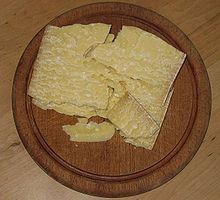
Gruyère is a hard Swiss cheese that originated in the cantons of Fribourg, Vaud, Neuchâtel, Jura, and Berne in Switzerland. It is named after the town of Gruyères in Fribourg. In 2001, Gruyère gained the appellation d'origine contrôlée (AOC), which became the appellation d'origine protégée (AOP) as of 2013.

Roquefort is a sheep milk blue cheese from southern France. Though similar cheeses are produced elsewhere, EU law dictates that only those cheeses aged in the natural Combalou caves of Roquefort-sur-Soulzon may bear the name Roquefort, as it is a recognised geographical indication, and has a protected designation of origin.

Swiss cuisine is an ensemble of national, regional and local dishes, consisting of the ingredients, recipes and cooking techniques developed in Switzerland or assimilated from other cultures, particularly neighboring countries. The diversity and comprehensiveness of Swiss gastronomy reflects the linguistic, cultural and geographical diversity. The climate of Switzerland allows for a large variety of terroirs, and therefore a wide range of indigenous food, from simple cereals to refined products like cheese and wine.

Emmental, Emmentaler, or Emmenthal is a yellow, medium-hard cheese that originated in the Emme valley, Switzerland. It is classified as a Swiss-type cheese.

In France, the appellation d'origine contrôlée(AOC) is a label that identifies an agricultural product whose stages of production and processing are carried out in a defined geographical area – the terroir – and using recognized and traditional know-how. The specificity of an AOC product is determined by the combination of a physical and biological environment with established production techniques transmitted within a human community. Together, these give the product its distinctive qualities.

Comté is a French cheese made from unpasteurized cow's milk in the Franche-Comté region of eastern France bordering Switzerland and sharing much of its cuisine. Comté has the highest production of all French Appellation d'origine contrôlée (AOC) cheeses, at around 66,500 tons annually. It is classified as an Alpine cheese.

Vacherin Mont d'Or, or simply Vacherin, is a cow's milk cheese. Two main types of French or Swiss Vacherin cheeses exist.

Cantal cheese is an uncooked firm cheese produced in the Auvergne region of central France: more particularly in the département of Cantal as well as in certain adjoining districts. Cantal cheese was granted Appellation d'Origine Contrôlée certification in 1956. One of the oldest cheeses in France, Cantal dates back to the times of the Gauls. It came to prominence when Marshal Henri de La Ferté-Senneterre served it at the table of Louis XIV of France. Senneterre is also responsible for the introduction of Saint-Nectaire and Salers.
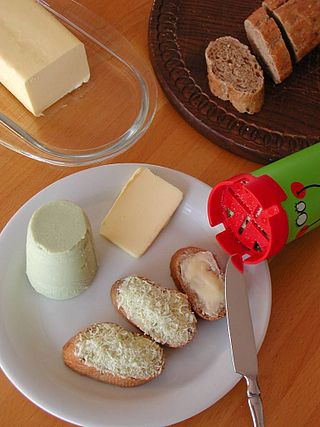
Schabziger or sapsago is traditional cheese exclusively produced in the Canton of Glarus in Switzerland. Schabziger is made out of the skimmed cow milk and a special kind of herb, blue fenugreek, also called blue melilot.

Tête de Moine AOP is a semi-hard cheese manufactured in Switzerland. It is classified as a Swiss-type or Alpine cheese, and was invented and initially produced more than eight centuries ago by the canons of the abbey of Bellelay, located in the community of Saicourt, district of Moutier, in the mountainous zone of the Bernese Jura, the French-speaking area of the Canton of Bern as well as the Canton of Jura.

Cheese is a dairy product produced in a range of flavors, textures, and forms by coagulation of the milk protein casein. It comprises proteins and fat from milk. During production, milk is usually acidified and either the enzymes of rennet or bacterial enzymes with similar activity are added to cause the casein to coagulate. The solid curds are then separated from the liquid whey and pressed into finished cheese. Some cheeses have aromatic molds on the rind, the outer layer, or throughout.

L'Étivaz is a hard Swiss cheese made from raw cow's milk. It is classified as a Swiss-type or Alpine cheese, and is very similar to Gruyère surchoix in taste.
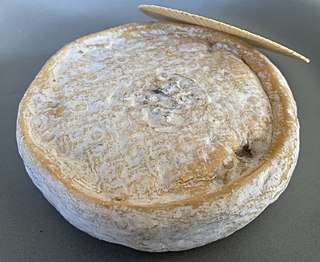
Chevrotin is a soft goat milk based cheese produced in the historical region of Savoy, (France). Since 2002 it has had an AOC designation.
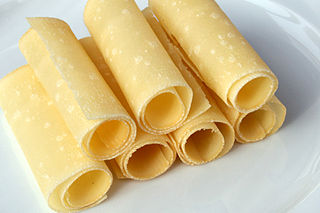
Berner Alpkäse is a hard cheese produced in the Alps of the Bernese Oberland and adjacent areas of Switzerland. It is classified as a Swiss-type or Alpine cheese, and is a spicy, full-fat, raw milk cheese without holes. The cheese is manufactured exclusively with manual labour, usually on a wood fire. An extra-hard variety of Berner Alpkäse, known as Berner Hobelkäse, is aged for at least two years and it is this variety that is most widely available. Both Berner Alpkäse and Berner Hobelkäse are certified as AOPs in Switzerland.
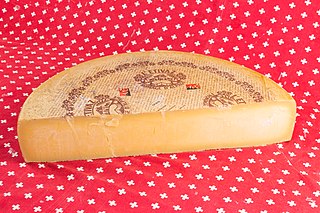
In Switzerland, the appellation d'origine protégée is a geographical indication protecting the origin and the quality of traditional food products other than wines.
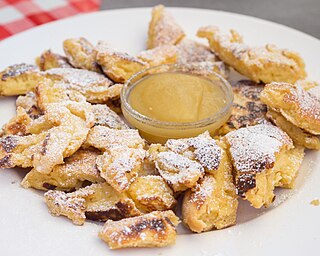
The regional cuisine of different regions of the Alps is called Alpine cuisine. Despite clear regional differences, this cuisine has been characterised throughout the entire Alpine region for centuries by the isolated rural life on the alpine huts and in the mountain villages. The staple foods that are still available today include milk and dairy products, cereals and desserts, as well as meat preserved by drying and smoking.

Vorarlberger Bergkäse is a regional cheese specialty from the Austrian state of Vorarlberg. It is protected within the framework of the European designation of origin (PDO).

Switzerland has a strong and ancestral dairy farming and cheesemaking tradition. The breeding of cattle, sheep and goats for milk is attested in the Neolithic period and, since Antiquity, cheese has been exported from the Alpine regions. The rugged nature of the country makes approximately 80% of the agricultural land unsuitable for cultivation, which is therefore mainly exploited for cattle and sheep farming. This mode of exploitation has forged a large part of the Swiss landscape, in the Alps, the Jura and on the Swiss Plateau.
The Brousse du Rove cheese, it is a type of goat milk cheese, made in Le Rove commune which is located in the Bouches-du-Rhône region in France.


